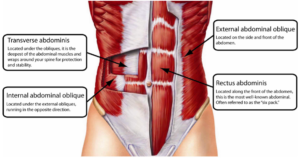Diastasis rectus abdominis (DRA) is a common health issue that most often affects pregnant and postpartum women but can also occur in males and nonpregnant females as well. By definition, DRA is a separation of the linea alba which is the fibrous fascial tissue that connects the right and left rectus abdominis.
DRA is defined and characterized by separation at one or more points of the linea alba that is at least 2 cm wide, along with a visible bulge in the abdominal area upon exertion. The linea alba also serves as an insertion point for three other important abdominal muscles; the internal and external obliques and the transversus abdominis. In conjunction with one another, the action of these abdominal muscles play an important role in expiration, defecation, urination, and child birth.
DRA can be caused by a number of mechanisms but most commonly it occurs during the third trimester of pregnancy due to stresses placed on the abdominal wall by a growing fetus. The mechanical stress of pregnancy in combination with the hormonal releases of progesterone, estrogen, and relaxin contribute to a weakening and separation of the linea alba.
Other risk factors for DRA include mechanical stresses placed on the abdominal wall from obesity or increased abdominal pressure during exercise. Certain individuals may have a congenital disposition for a weakened abdominal wall and abdominal surgeries can also create a vulnerability for a person to acquire DRA later in their life.
The affects and symptoms most commonly associated with DRA are impaired pelvic stability, a vulnerability to injury, low back pain, as well as defects in respiration, and pelvic floor functions.
DRA can easily be diagnosed by your physical therapist and is quite apparent upon physical examination. In certain circumstances an ultrasound may be needed to differentiate it from a midline hernia but a physical therapist can palpate the abdominal region and measure the size of the separation by use of manual techniques. DRA does not represent a true hernia therefore often not needing surgical repair. Conservative management of exercise and weight loss are advised as being the first line of treatment.
Treatment proven to be significant and affective for DRA as well as an alternative to having surgical intervention is a deep core stability-strengthening program. This particular type of program includes abdominal bracing during exercise, diaphragmatic breathing, pelvic floor contractions, planks, and isometric abdominal contractions. Deep core stability-strengthening programs have been proven to decrease the inter-recti separation in DRA as well as generally improve quality of life by decreasing pain and improving lung function.
During pregnancy deep core stability-strengthening programs have also been proven to be effective for prevention of DRA.

| Diaphragmatic breathing | 1-2x per day, 2-3 minutes, 4 second long inhales and 4 second long exhales |
| Bracing with toe taps | 3 sets of 10 repetitions with brace, 10 seconds of relaxation between sets |
| Dead bug with isometric contraction | 3 sets of 10 repetitions, hold each repetition for 4 seconds, 10 seconds of relaxation between sets |
If your symptoms are mild or moderate, and you are not having progressive nerve problems, you may benefit from conservative care such as physical therapy.
Innovative Physical Therapy, “Solutions in Motion”
619-260-0750
References
Efficacy of deep core stability exercise program in postpartum women with diastasis recti abdominis: A randomised controlled trial. (n.d.). Retrieved November 30, 2020, from https://www.readkong.com/page/efficacy-of-deep-core-stability-exercise-program-in-9802779
